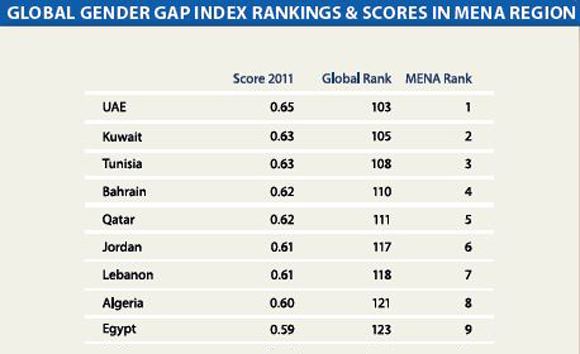Gender Equality and Education in MENA Region
World Economic Forum indicates the UAE tops MENA countries in gender equality.

The UAE has seen its gender equality score improving relative to last year and continues to top MENA countries on the Global Gender Gap Index, according to a new report by the World Economic Forum. In fact the UAE (ranked 103rd globally), along with some other regional countries, boasts of more women than men enrolling for tertiary education, according to the report.
The highest-ranking economies of the region have invested many resources in increasing women’s education levels – in Qatar, Kuwait, the UAE, Tunisia, Algeria, Saudi Arabia, Lebanon and Jordan, the tertiary education enrollment rates of women are higher than those of men, as per the report.
The Global Gender Gap Index introduced by the World Economic Forum in 2006, is a framework for capturing the magnitude and scope of gender-based disparities and tracking their progress. The Index benchmarks national gender gaps on economic, political, education- and health-based criteria, and provides country rankings that allow for effective comparisons across regions and income groups, and over time.
The highest-ranking economies of the region have invested many resources in increasing women’s education levels – in Qatar, Kuwait, the UAE, Tunisia, Algeria, Saudi Arabia, Lebanon and Jordan, the tertiary education enrollment rates of women are higher than those of men, as per the report. However, these countries have had varying degrees of success at integrating women into the economy in order to reap the benefits of this investment, according to the World Economic Forum.
Kuwait (105th worldwide), Tunisia (108th globally) and Bahrain (110th globally) follow in the rankings, supported by higher-than-average performances on education attainment and health and survival. While Kuwait is the second-highest-ranking country in the region, it is one of only 9 countries out of 135 that show a worsening gap in the literacy rate indicator, as indicated in the report.
Tunisia fell one place in the rankings this year. In the absence of new political data, the political empowerment data have been repeated from last year in order to continue to observe other changes in score. Bahrain’s ranking does not change despite a small overall gain in the score, as other countries move ahead faster.
Qatar (111th globally), Jordan (117th globally) and Lebanon (118th worldwide) follow Tunisia’s ranking on the Global Gender Gap Index regionally. Qatar’s strength lies in education, especially secondary and tertiary education, although reductions in wage gaps over the last year have boosted Qatar’s overall ranking by six places.
Jordan gained three places, most notably through an increase in the percentage of women in parliamentary positions (from 6% to 11%). Jordan’s key strength continues to lie in the area of education where primary, secondary and tertiary enrollment rates of girls are higher than those of boys. Lebanon lost two positions relative to last year, although it is the only country in the region to have achieved parity on the health and survival sub-index.
Oman and Saudi Arabia, along with Morocco and Yemen, bring out the bottom of the regional rankings. Oman dropped down, losing five places. This is partly the result of a wider gap in tertiary enrollment. Yemen continues to occupy the last place in the region as well as in the overall rankings of 135 countries. While showing an absolute increase in the score, it remains the only country in the world to have closed less than 50% of its gender gap.
With just 59% of the gender gap closed, the Middle East and North Africa (MENA) region occupies last place on overall average score compared with the other five regions (Sub-Saharan Africa, Asia and the Pacific, Latin America and the Caribbean, Europe and Central Asia, and North America). The MENA region lags behind the other regions on the economic participation and opportunity and the political empowerment sub-indexes. It is in 5th position on educational attainment (ahead of sub-Saharan Africa) and 4th position on health and survival (ahead of both sub-Saharan Africa and Asia and the Pacific).
The article above has been published as a part of Bank Audi`s MENA Weekly Monitor of Week 46 (2011). It can be accessed via Internet at the following web address: http://www.banqueaudi.com